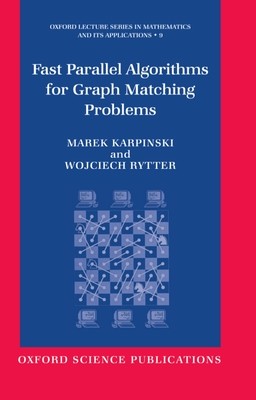
- We will send in 10–14 business days.
- Author: Marek Karpinski
- Publisher: Clarendon Press
- ISBN-10: 0198501625
- ISBN-13: 9780198501626
- Format: 15.6 x 23.4 x 1.4 cm, hardcover
- Language: English
- SAVE -10% with code: EXTRA
Fast Parallel Algorithms for Graph Matching Problems (e-book) (used book) | bookbook.eu
Reviews
Description
The matching problem is central to graph theory and the theory of algorithms. This book provides a comprehensive and straightforward introduction to the basic methods for designing efficient parallel algorithms for graph matching problems. Written for students at the beginning graduate level, the exposition is largely self-contained and example-driven; prerequisites have been kept to a minimum by including relevant background material. The book contains full details of several new techniques and will be of interest to researchers in computer science, operations research, discrete mathematics, and electrical engineering. The main theoretical tools are presented in three independent chapters, devoted to combinatorial tools, probabilistic tools, and algebraic tools. One of the goals of the book is to show how these three approaches can be combined to develop efficient parallel algorithms. The book represents a meeting point of interesting algorithmic techniques and opens up new
algebraic and geometric areas.
EXTRA 10 % discount with code: EXTRA
The promotion ends in 16d.10:02:49
The discount code is valid when purchasing from 10 €. Discounts do not stack.
- Author: Marek Karpinski
- Publisher: Clarendon Press
- ISBN-10: 0198501625
- ISBN-13: 9780198501626
- Format: 15.6 x 23.4 x 1.4 cm, hardcover
- Language: English English
The matching problem is central to graph theory and the theory of algorithms. This book provides a comprehensive and straightforward introduction to the basic methods for designing efficient parallel algorithms for graph matching problems. Written for students at the beginning graduate level, the exposition is largely self-contained and example-driven; prerequisites have been kept to a minimum by including relevant background material. The book contains full details of several new techniques and will be of interest to researchers in computer science, operations research, discrete mathematics, and electrical engineering. The main theoretical tools are presented in three independent chapters, devoted to combinatorial tools, probabilistic tools, and algebraic tools. One of the goals of the book is to show how these three approaches can be combined to develop efficient parallel algorithms. The book represents a meeting point of interesting algorithmic techniques and opens up new
algebraic and geometric areas.


Reviews